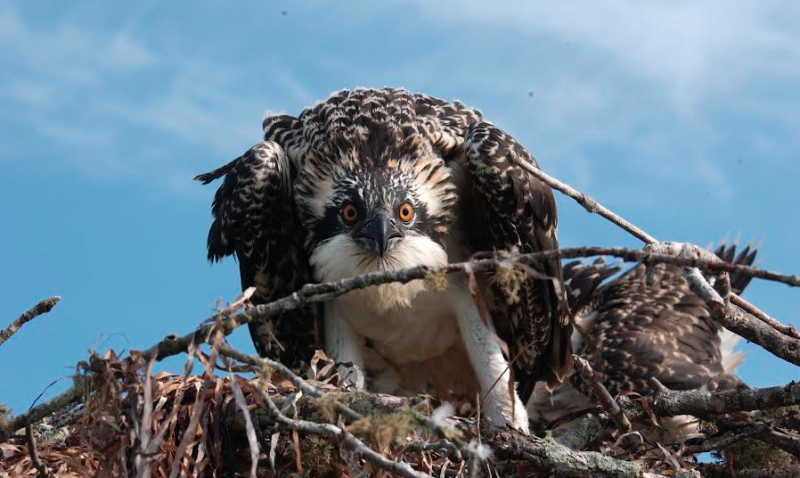With public support, osprey population soars
Conservation efforts have given ospreys a platform to expand their area population.
Driven to near extinction by the use of DDT in the first half of the 20th century, the birds that gave Buzzards Bay its name are back in force. Nesting on platforms constructed by conservationists, the population is spreading its wings to claim other high spots, even causing one recent power outage.
One reason for the osprey success story has been the construction of tall poles topped with platforms used for nesting. These have helped osprey find a safe place to land, free from predators and human interference.
At the Lloyd Center for the Environment and Allens Pond Wildlife Sanctuary in Dartmouth, these poles have been placed on their properties to provide a safe home for the osprey and to allow scientists at both locations to study them.
Placement is crucial, said Jamie Bogart, research associate at the Lloyd Center for the Environment.
These nesting poles are ideally located near water sources such as salt marshes that provide the fish that comprise the vast majority of the ospreys’ diet, he said, and away from tree lines where great horned owls can grab the chicks.
Predator guards are often placed at the bottom of the poles, he noted, to deter climbing predators, particularly raccoons, from accessing the nests.
Environmentalists hope that ospreys will be drawn to these safe locations.
But that isn’t always the case.
Tall, freestanding structures such as utility poles, construction cranes and fishing derricks can tempt the birds to use them as nesting sites, said Gina Purtell, Mass Audubon program manager for coastal resilience and community science.
Sometimes the results can be dangerous for the birds and troublesome for the public.
One of the more notable occurrences was a power failure in May that was blamed on an osprey building a nest on a utility pole in the Tobey Hospital area in Wareham. Downed wires led to an electrical fire, small brush fires and widespread power, Internet and cable outages, according to Wareham Week.
Eversource is taking steps to reduce the chance that ospreys will nest on power lines, according to William H. Hinkle, a spokesperson for Eversource.
From January to March, ahead of the osprey’s arrival into the area, the company makes “extensive patrols of our local electrical system,’’ Hinkle said. The company removes dozens of nests and installs deterrents, platforms and other mitigation efforts, he said.
“We will continue working with local officials, environmentalists and the birding community to improve and refine our processes so that we can achieve our shared goal of protecting osprey without impacting reliability,’’ he said.
The key to keeping ospreys away from potential danger is to understand when they nest and what they are searching for, Purtell said.
“Being aware of timing, that’s the message,’’ she said.
It all comes down to roughly four weeks, Purtell said.
The last two weeks in March through the first two weeks of April, the osprey arrive in the area from their southern migration and look for nesting locations.
During those times, steps can be taken to prevent ospreys from nesting where they shouldn’t be.
“Modify how you use things during that time,’’ Purtell advised.
Construction cranes, for example, can be lowered when a work site is quiet. The noise and traffic of the workday will deter the birds, she said, but they can be drawn to the site after hours.
Utility companies can construct platforms on poles that will strictly be used for osprey in hopes they will avoid the utility poles, she said. They should take steps to ensure the osprey poles are taller than the actual utility poles with platforms potentially built of metal or fiberglass to last longer, she said.
Such steps can help ensure the health of the osprey population.
Their comeback brings the bird’s South Coast population full circle.
The birds were so prevalent in the area that early settlers coined the term “Buzzards Bay,’’ because of the birds they saw near the shore.
The birds, in fact, were ospreys, Purtell said.
But their once-healthy population declined to the point of near extinction by the 1950s and 1960s, environmentalists reported. This was attributed in large part to widespread use of the pesticide DDT.
In 1972, DDT use was banned in the United States and osprey numbers began to grow. They were reintroduced into the area and platforms were built in hopes of expanding their numbers.
One way to encourage osprey to nest where they should be safely located, she said, is to support the South Coast Osprey Project, which maintains osprey platforms and studies the birds’ population and well-being.
This project helps ensure that osprey nest where they should be and avoid where they shouldn’t, she said.
The birds play a valuable role in studying other area wildlife, she said. Since fish make up most of their diet, studying ospreys can also shed light on the fish populations in the area, for example.
“They are a window, a very clear and visible window into the natural world,’’ she said. “They draw our attention to the vulnerable habitat where more sensitive species are at risk.’’
To learn more about the South Coast Osprey Project, visit massaudubon.org/osprey and follow the links.

















